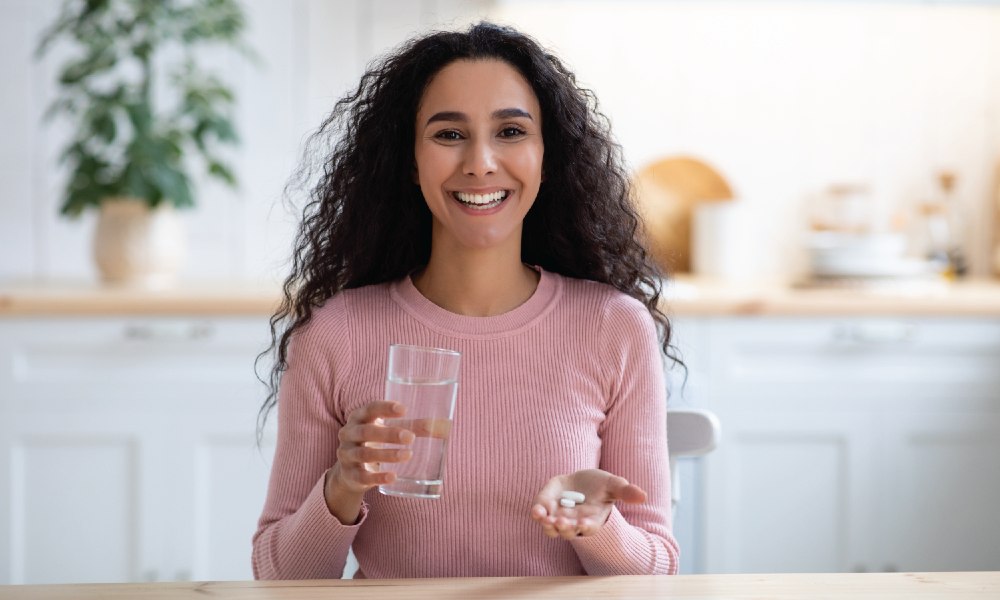
Zinc: Do something Good for your Health and Beauty

In today’s fast-paced world, where stress and environmental factors continually challenge our well-being, it’s essential to nurture both our inner beauty and our immunity. What you might not be aware of is that there’s a hidden gem that can help you achieve both: zinc. Zinc has a handful of benefits that are good for your health and beauty.
The Role of Zinc in the body:
Zinc is an essential mineral that the body cannot produce on its own, and it must be obtained through diet. It’s a vital nutrient that supports a healthy immune system, skin, hair, and nails. It also plays a role in the synthesis and function of proteins like keratin and collagen, which provide structure to hair, skin, and nails(1). Furthermore, by supporting antioxidant function and hormone regulation, zinc can help support wound healing and healthy skin – all essential for you to support a glowing, healthy appearance(2).
Despite its significance, nearly 1 in 5 Americans don’t get enough zinc in their diets(3), and globally more than 1.4 billion have a lower zinc intake compared to the recommended dietary intake(4).
How to Ensure You’re Getting Enough Zinc for Health and Beauty
Nutrition is a crucial factor affecting the overall health and appearance of the skin. As our largest organ, the skin is often one of the first to show signs of poor nutrition. Science has proven that nutritional deficiencies and lifestyle-related health issues result in visible changes to the skin, hair, and nails(5).
While zinc is found in many foods, many people may not get enough zinc in their diets. The Recommended Daily Allowance (RDA) of zinc for adults is 8-11 milligrams per day, depending on gender, age, and pregnancy/lactation status(1). Here are a few tips for ensuring you’re getting enough zinc in your diet:
- Eat zinc-rich foods: Oysters, beef, and pumpkin seeds are all good sources of zinc. Other foods that are high in zinc include shellfish, chicken, beans, and nuts(6).
- Be mindful of zinc absorption inhibitors: Some foods, such as phytates in whole grains and legumes, can inhibit the absorption of this essential nutrient(1).
- Consider a zinc supplement: If you’re not getting enough zinc in your diet, a supplement may be recommended by your healthcare provider.
Where does Balchem fit in?
Let our team of experts help make a significant difference in providing product solutions, like Zinc, that are good for health and beauty. In our Albion® Minerals portfolio, we employ cutting-edge science and patented technology to create unique organic mineral forms known as amino acid chelates, mirroring nature’s design. Our chelated zinc form – the Zinc Bisglycinate that powers our Z-Life™ brand of products – has been shown in clinical trials to be up to 50% better absorbed than conventional zinc salts such as zinc gluconate(7).
Zinc Max is the newest zinc bisglycinate chelate innovation and it provides an impressive 27% elemental zinc. This is the highest concentration zinc product offered by Balchem, making it a powerful addition to your product formulation.
This product is a fantastic innovation for immunity product concepts, and it also plays a significant role in the trending beauty space, offering unique benefits such as superior absorption and multiple health benefits. Its flexibility in formulations, even within complex ones, demonstrates its adaptability to a wide range of product applications – from tablets, capsules, and soft gels, to trending formats such as gummies, powders, beverages, and more!
At Balchem®, we strive to deliver the best nutritional benefits for consumers and enrich almost every product idea. Let us be your trusted partner, whether you want to focus on immunity, beauty, or a combination of both.
Interested in learning more?
References
- Food and Nutrition Board, Institute of Medicine, 2001. Dietary Reference Intakes for Vitamin A, Vitamin K, Arsenic, Boron, Chromium, Copper, Iodine, Iron, Manganese, Molybdenum, Nickel, Silicon, Vanadium, and Zinc. Available at: https://www.ncbi.nlm.nih.gov/books/NBK222317/
- Al-Khafaji, Z., Brito, S., & Bin, B. H. (2022). Zinc and Zinc Transporters in Dermatology. International journal of molecular sciences, 23(24), 16165. https://doi.org/10.3390/ijms232416165
- USDA, Agricultural Research Service, 2023. Total Usual Nutrient Intake from Food, Beverages, and Dietary Supplements, by Gender and Age, What We Eat in America, NHANES 2017-March 2020 Prepandemic. Available at: http://www.ars.usda.gov/nea/bhnrc/fsrg
- Wessells, K. R., & Brown, K. H. (2012). Estimating the global prevalence of zinc deficiency: results based on zinc availability in national food supplies and the prevalence of stunting. PloS one, 7(11), e50568. https://doi.org/10.1371/journal.pone.0050568
- Agedew, E., Tsegaye, B., Bante, A., Zerihun, E., Aklilu, A., Girma, M., Kerebih, H., Wale, M. Z., & Yirsaw, M. T. (2022). Zinc deficiency and associated factors among pregnant women’s attending antenatal clinics in public health facilities of Konso Zone, Southern Ethiopia. PloS one, 17(7), e0270971. https://doi.org/10.1371/journal.pone.0270971
- https://ods.od.nih.gov/factsheets/Zinc-HealthProfessional/
- DiSilvestro RA, et al; Biol Trace Elem Res, 2015; 168(1): 11-14/ https://www.incaparina.com/articulos_cientificos/zinc-study-2015.pdf

